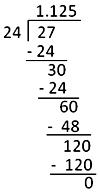Subscribe to our ▶️ YouTube channel 🔴 for the latest videos, updates, and tips.
Terminating Decimal
While expressing a fraction in the decimal form when we perform division we notice that the division is complete after a certain number of steps i.e., we get the remainder zero. The quotient obtained as decimal is called the terminating decimal. Such a decimal has a finite number of terms after the decimal point.
Worked-out examples on terminating decimal:
1. Express 17/8 in the decimal form.
Solution:
Since, the remainder is zero.
Therefore, 17/8 is terminating and 2.125 is a terminating decimal.
2. Express 1/4 in the decimal form.
Solution:
= 0.25
Since, the remainder is zero.
Therefore, 1/4 is terminating and 0.25 is a terminating decimal.
3. Express 3/5 in the decimal form.
Solution:
= 1.125
Since, the remainder is zero.
Therefore, 27/24 is terminating and 1.125 is a terminating decimal.
4. Express 3/5 in the decimal form.
Solution:
= 0.6
Since, the remainder is zero.
Therefore, 3/5 is terminating and 0.6 is a terminating decimal.
● Related Concept
● Decimals
● Conversion of Unlike Decimals to Like Decimals
● Decimal and Fractional Expansion
● Converting Decimals to Fractions
● Converting Fractions to Decimals
● H.C.F. and L.C.M. of Decimals
● Repeating or Recurring Decimal
● BODMAS/PEMDAS Rules - Involving Decimals
● PEMDAS Rules - Involving Integers
● PEMDAS Rules - Involving Decimals
● BODMAS Rules - Involving Integers
● Conversion of Pure Recurring Decimal into Vulgar Fraction
● Conversion of Mixed Recurring Decimals into Vulgar Fractions
● Rounding Decimals to the Nearest Whole Number
● Rounding Decimals to the Nearest Tenths
● Rounding Decimals to the Nearest Hundredths
● Simplify Decimals Involving Addition and Subtraction Decimals
● Multiplying Decimal by a Decimal Number
● Multiplying Decimal by a Whole Number
● Dividing Decimal by a Whole Number
● Dividing Decimal by a Decimal Number
7th Grade Math Problems
From Terminating Decimal to HOME PAGE
Didn't find what you were looking for? Or want to know more information about Math Only Math. Use this Google Search to find what you need.






New! Comments
Have your say about what you just read! Leave me a comment in the box below. Ask a Question or Answer a Question.